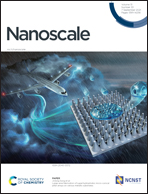Enhancing upconversion of manganese through spatial control of energy migration for multi-level anti-counterfeiting†
Abstract
The upconversion of manganese (Mn2+) exhibits a green light output with a much longer lifetime than that of lanthanide ions, showing great potential in the frontier applications like information security and anti-counterfeiting. Mn2+ can be activated by energy migration upconversion. However, there exists serious quenching interactions between Mn2+ and the lanthanides at the core–shell interfacial area, which would markedly reduce the role of Tm3+ as a ladder to facilitate the up-transition and subsequently limit the upconversion of Mn2+. Here, we propose a mechanistic strategy to enhance the upconversion luminescence of Mn2+ by spatial control of energy migration among Gd sublattice through introducing an additional migratory NaGdF4 interlayer within the commonly used core–shell nanostructure. This design can not only isolate the interfacial quenching interactions between the sensitized core and luminescent shell, but also allow an efficient channel for energy transport, resulting in enhanced upconversion of Mn2+. Moreover, the relatively long lifetime of Mn2+ (around 32.861 ms) provides new possibilities to utilize the temporal characteristic for the frontier application of multi-level anti-counterfeiting through combining the time-gating technology.



 Please wait while we load your content...
Please wait while we load your content...